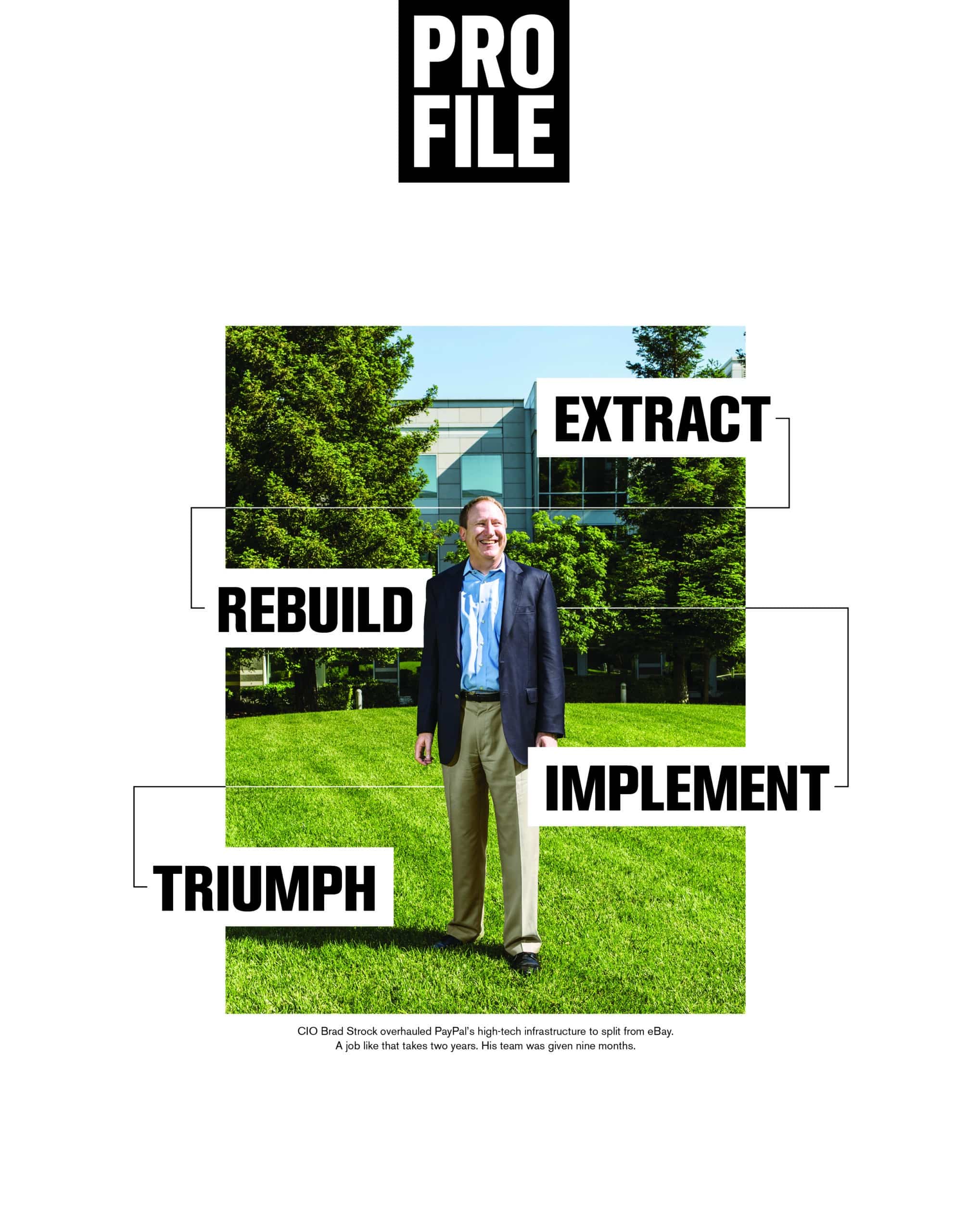It was the end of an era.
After a thirteen-year partnership, eBay and PayPal announced intentions to split.
Each company was free to control its own destiny.
That year, 2014, PayPal had 162 million active accounts that together generated more than four billion transactions and revenues of $8.012 billion. To continue driving those numbers forward, the newly independent company that once shared its corporate IT infrastructure with eBay would have to stand on its own.
Brad Strock, chief information officer, knew the company would have to split applications, build new data centers, and create an entirely new corporate network to support the global leader in online payments. Industry experts said the transition should take up to two years; Strock and his team were given just nine months.
Despite the aggressive deadline, Strock accepted the challenge. He grew up sweeping floors in his family’s hardware store, where he often helped customers solve simple mechanical and electrical problems. Talent and interest led him to study mechanical engineering and pursue an MBA. Soon, Strock found himself working for a Fortune 300 company doing M&A work, but he would often stay late to string network cables, talk to technologists, and tinker with electronics. He built a robust home network and his own PCs, nurturing his growing passion for technology. Ultimately, he decided to adjust his career accordingly.

Strock looked for the chance to take more steps into the tech world, and as vice president of marketing technology and infrastructure at Bank One, he built a tech system for a new 600-person telemarketing team. When JPMorgan Chase acquired Bank One, Strock oversaw the creation of a customer loyalty program platform and standardized rewards from more than seventy other systems. His team slashed operating expenses by 20 percent.
At Bank of America, Strock led teams supporting customer service technologies and next-generation payments, where he reduced technology incidents by 80 percent and generated more than $200 million in productivity improvements. He joined PayPal in 2011 and became the company’s CIO in 2014. His workforce of 1,500 supports 25,000 end users, 900 applications, three data centers, and 15,000 servers in more than sixty locations worldwide.
In late 2014, when eBay and PayPal announced the split, Strock developed a plan his team could execute against. They had just nine months to build all tech capabilities for a complex and high-tech company. “We were unwinding and reconnecting what the team had spent the prior decade stitching together,” Strock says. “And we had to do it very quickly.”
People and talent became critical. Strock gave junior team members more responsibility and asked nearly everyone to stretch. “We gave people more work than they were ready for because we didn’t have a choice,” he says. “We stretched and tested our team, but we trusted them, too. In every case, we supported the people we had in place.”
In a fast-moving and demanding project, it’s natural for morale to take a hit or for employees to experience burnout, but Strock took preemptive action to prevent negative side effects. “We addressed most questions up front, communicated frequently, and tried to accommodate as many desires as possible in terms of role,” he explains.
“I’ve never seen a team fail because the person in charge was a great leader but didn’t have the technical chops. But I’ve seen plenty crash and burn due to weak leadership skills.”
Brad Strock
The demands of the project also required Strock to set expectations with PayPal’s business leaders—he wanted them to understand the challenges and risks of the task. “With a highly complex environment and little time, we were bound to break some things, and I needed their understanding and support,” he says. Next, Strock and his leaders in IT set clear objectives and attainable goals. They assigned accountability for each major outcome to one just person and tracked all results.
Additionally, they avoided massive, simultaneous changes and worked in digestible increments to reduce the risk of costly delays near the project’s delivery date. Those strategies worked, as PayPal’s IT team successfully delivered two weeks before the scheduled deadline.
With its own system up and running, the new public company saw its value soar above eBay’s market cap to nearly $49 billion on its first day of trading. As buyers embrace mobile payments in increasing numbers, PayPal again finds itself in growth mode, as revenues increased by 21 percent and transaction volumes climbed by 25 percent in the fourth quarter of 2015.
When the dust had settled, and with everything running smoothly, Strock and other PayPal leaders made time to celebrate his team’s achievement. CEO Dan Schulman thanked the department in person, and Strock offered varying levels of recognition. “There’s nothing I can do to give back what my team sacrificed, but it’s important for each person to know that their work matters, that we see them, and that they are deeply and truly appreciated,” Strock says.
As a CIO, Strock knows just how important that recognition is in creating a good internal culture. He wants to create an environment that lures and retains top talent. “My own career story is one of aligning my passion with my vocation. People that do that are usually successful in their work life, and I want everyone at PayPal to have that same opportunity,” he says. Whether bringing in new workers (Strock fills 30 percent of open positions with recent graduates) or promoting internal candidates, PayPal’s IT department focuses on skill development and career life cycle.
For a business with aspirations like PayPal’s, diversity plays an important role. The department skews high in every relevant measure, including women in leadership. “We want a diverse team that brings a wide variety of experience and perspective because it’s the right thing to do, and because it makes good business sense. Few tech companies are doing it well, and those that are will have an advantage,” Strock says.
Throughout his career, Strock has been on teams that have demonstrated the importance of good leadership. “I’ve never seen a team fail because the person in charge was a great leader but didn’t have the technical chops. But I’ve seen plenty crash and burn due to weak leadership skills,” he explains. Now in building his core team, the veteran CIO looks for diversity and leadership skills first, and technical acumen second.
This is the philosophy that Strock is using to take the independent PayPal into the future. Together, his IT leaders are working to enable employees to be productive, innovative, and nimble through the use of technology. With a successful initial public offering in the rearview and a diverse team in place, the company is ready to take on both existing and emerging competition in this highly competitive space. ×
“As a CIO in Silicon Valley, the eBay and PayPal separation was often a topic of conversation. It is very impressive what PayPal was able to accomplish in such a short period of time, but what I find most interesting is the reasons cited for that success are not budget, cloud, and strategy, but are leadership, communication, recognition, and trust. It is virtually impossible to accomplish the impossible without these being the culture of the initiative.” —Guest Editor Julie Cullivan, SVP of Business Operations and CIO at FIreEye




















